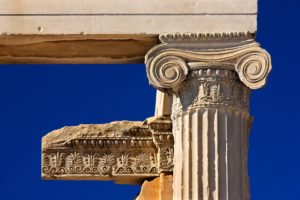The Phaistos Disc, one of antiquity’s significant puzzles!
The Phaistos Disc (also spelled Phaistos Disk, Phaestos Disc) is a disk of fired clay from the Minoan palace of Phaistos on the island of Crete. Scientists place the disk’s creation to the middle or late Minoan Bronze Age (second millennium B.C.). You can zoom in and try as well to make meaning of its strange symbols since they have been puzzling mankind greatly since it’s discovery…
The Disc
The double-sided clay disc, roughly 10.5 cm in diameter, was discovered by Italian archaeologist Luigi Pernier during an excavation of Phaistos, the site of a Minoan palace in Crete. While the disc is named from its discovery place, the absence of similar artifacts in the region suggests that the site is not it’s actual place of origin.
You can observe that a strange inscription dominates the disk. This was apparently made by pressing pre-formed hieroglyphic “seals” into the soft clay, clockwise and spiraling toward the center of the disk. The clay was then fired at high temperature. The unique character of the Phaistos Disc stems from the fact that the entire text was inscribed in this way. If you are now thinking the words “typography” or “printing press,” you may be on to something! The disc is undoubtedly the earliest sample of reproducing a body of text with reusable characters.
Predictably, skeptics have suggested that the Phaistos Disc is a forgery and a hoax, but most experts have found little reason to doubt its authenticity. You can see the Phaistos Disc on display at the Heraklion Archaeological Museum in Crete.
The signs
You can count a total of 242 tokens on the disc, comprising of 45 distinct signs. Many of these 45 signs represent easily identifiable every-day things. In addition to these, there is a small diagonal line that occurs underneath the final sign in a group a total of 18 times. The disc shows traces of corrections made by the scribe in several places.
Arthur Evans numbered the 45 symbols from 01 to 45, and this numbering has become the conventional reference used by most researchers. Some researchers compare these symbols with Linear A characters. Other scholars (J. Best, S. Davis) have pointed to similar resemblances with the Anatolian hieroglyphs, or with Egyptian hieroglyphs (A. Cuny).
The puzzle solved?
Now, you can go on and wonder what these signs could mean. Researchers have been puzzled since it’s discovery, to little avail. All until now…
Dr. Gareth Owens of the Technological Educational Institute (TEI) of Crete believes the disk is dedicated to a mother.
‘The most stable word and value is “mother” and in particular the mother goddess of the Minoan era,’ he said in a public talk at the Institute. He looked at groupings of signs found on three of parts of one side of the disk to come up with this theory. They spell out I-QE-KU-RJA, and he said that I-QE means ‘great lady of importance.’
On the other side of the double-sided disk, he identified the word AKKA, which he says means ‘pregnant mother’. Therefore, he thinks that one side is dedicated to a pregnant woman and the other to a woman giving birth.
Speaking in a TED talk in May, Owens explained how he worked with John Coleman at Oxford University for six years to crack the code.
‘It’s the closest thing to a partial Minoan Rosetta Stone,’ he said, stating that they can now read 90% of ‘Side A’ of the disk.
Their next challenge is to work out exactly what the signs mean, but Dr. Owens is sure it is a ‘genuine Minoan religious inscription.’
Sources: Wikipedia, Amusing Planet, Lonely Planet, Atlas Obscura


